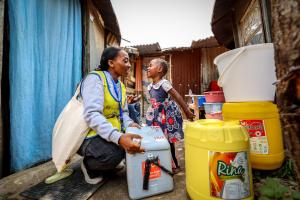Kenya, Uganda cross-border polio vaccination reaches 6.5 million children
Nairobi/Kampala – Between October 3 and 6, 2024, more than 6.5 million children were vaccinated in a successful synchronized polio campaign between Kenya and Uganda. This cross-border achievement began with a coordinated launch in Bungoma District, Kenya, and Mbale District, Uganda.
Both countries have set an exemplary standard in their recent synchronized polio vaccination campaign conducted this week, which focused on high-risk cross-border regions. By conducting these campaigns on the same dates, sharing real-time information, both countries ensured that children under five in these vulnerable areas were reached effectively, reducing the chance of cross-border virus transmission. This joint effort is the result of recent detections in Kenya (with 6 polioviruses in 2024 alone) and Uganda (with 1 virus reported this year through environmental surveillance) and it reflects the broader principle that no child should be left unprotected simply because they live near an international boundary.
“Our health workers will vaccinate every child against polio door-to-door. Vaccination has eradicated many diseases in Uganda. We thank all our partners for their support in ensuring a polio-free future. Protect your children from paralysis & vaccinate today”. Said Dr. Daniel Kyabayinze, the Director of Public Health in the Ministry of Health of Uganda.
Health authorities have therefore put in place common strategies not only at national levels in Kenya and Uganda, but also regionally, with particular focus on all the 10 districts bordering both countries, covering a total of 772 kilometers.
“The virus is spreading fast in the East African region putting our children – particularly aged 5 years or below at the risk of contracting this incurable yet vaccine-preventable disease” – affirmed Dr. Charles Njuguna, the World Health Organization (WHO) country representative in Uganda.
This entailed putting in place micro plans: mapping the cross-border communities, migratory routes, cross-border entry/exit points, and transit routes for each of the cross-border facilities.
“The Current Polio outbreak in Eastern Africa is fueled by heavy movement of high-risk populations between countries. The decision by the Governments of Kenya and Uganda to conduct two synchronized in October 2-6 and November 6-10 is a laudable effort support by the GPEI partnership”. – confirmed the Global Polio Eradication Initiative Coordinator in Kenya, Charles Korir.
The collaborative initiative comes as part of a broader strategy supported by the World Health Organization (WHO) and other GPEI partners, aiming to close immunization gaps and address the persistent challenge of "zero-dose" children—those who have never been vaccinated. Both Kenya and Uganda have recognized that polio eradication cannot be achieved in isolation, and their united front is a powerful example of how regional cooperation can help achieve public health goals.
Polio knows no borders, and neither should the fight to eradicate it. Cross-border communities, especially those living in remote or nomadic areas, are at heightened risk of infection due to their mobility and the porous nature of international boundaries. This is why the coordination of vaccination efforts between neighboring countries is critical to achieving comprehensive immunization coverage, so that the risk of paralysis due to the virus can be avoided.
As the world moves closer to eradicating polio, this synchronized approach will be key in ensuring that no pockets of the virus remain in these hard-to-reach areas. Kenya and Uganda's coordinated actions not only protect their own populations but also contribute to global health security by preventing the virus from spreading beyond their borders.
This collaboration serves as a model for other countries facing similar challenges. By continuing to prioritize cross-border vaccination synchronization, Kenya, Uganda, and their health partners are leading the way toward a polio-free future for all.



